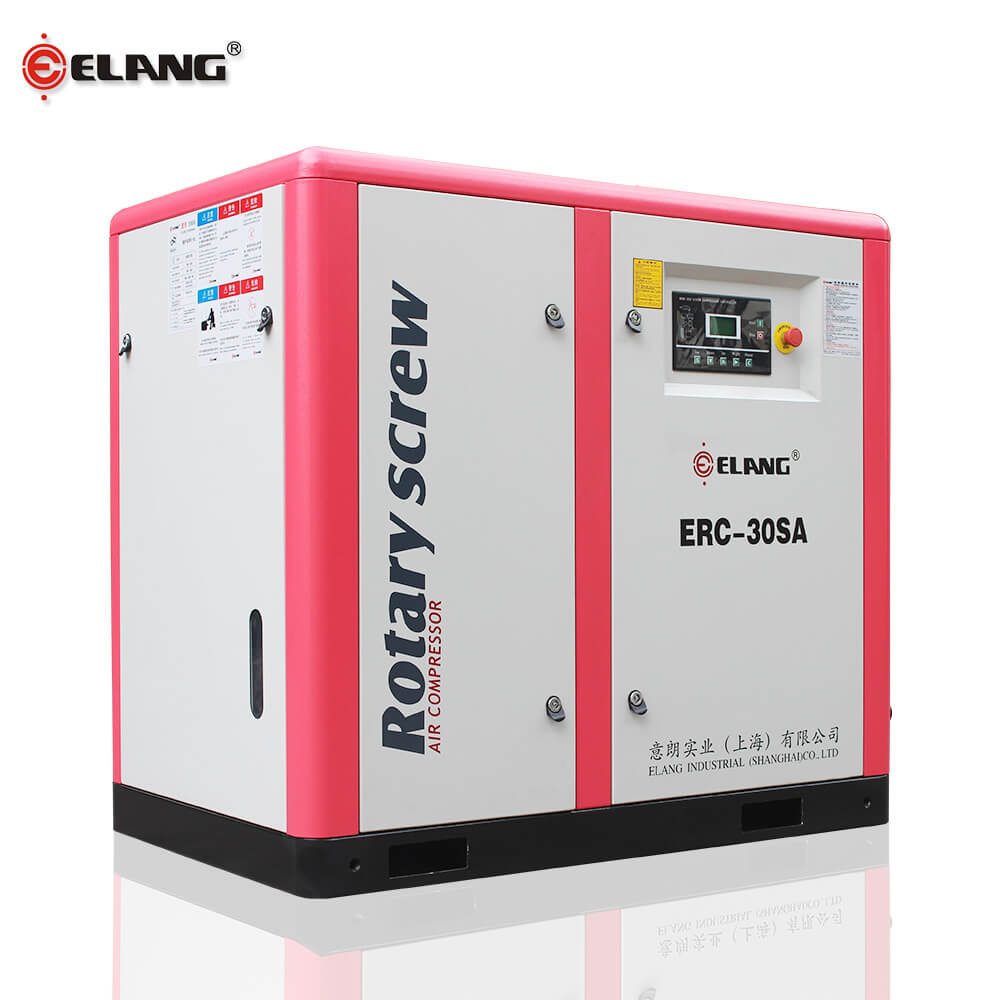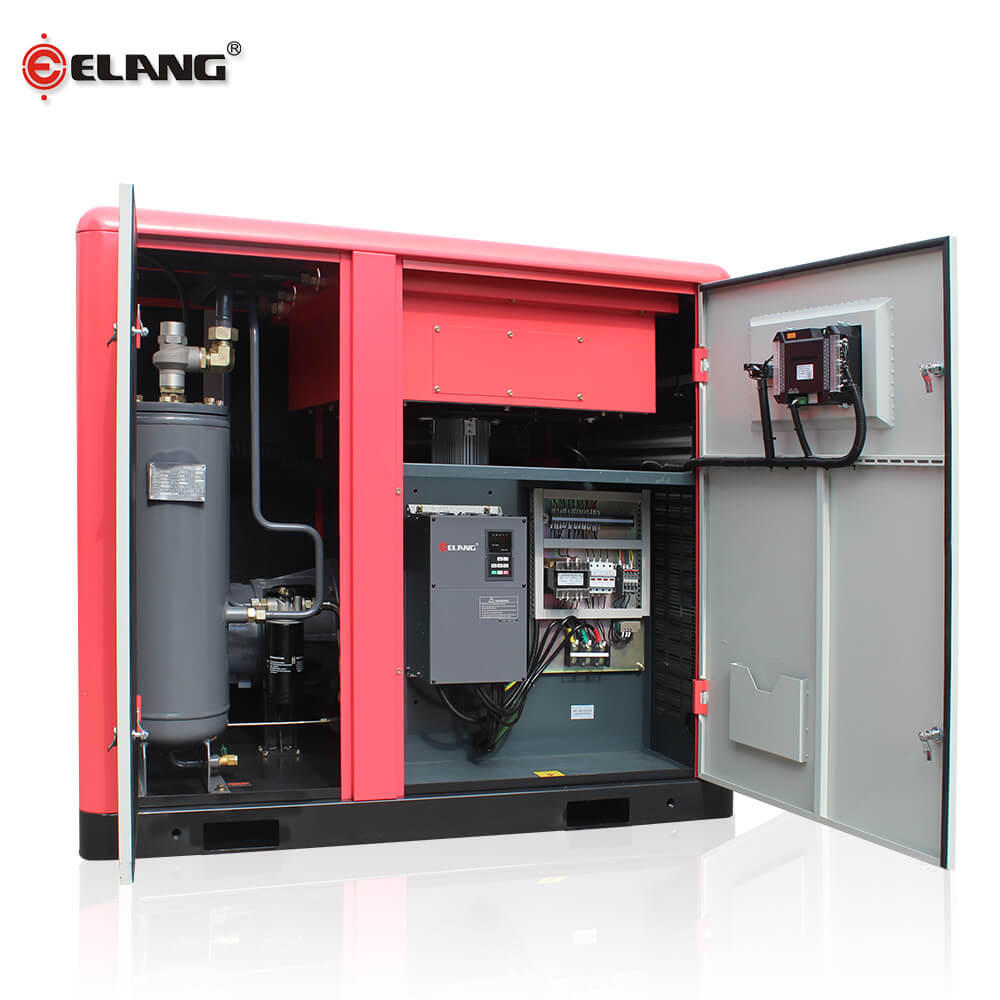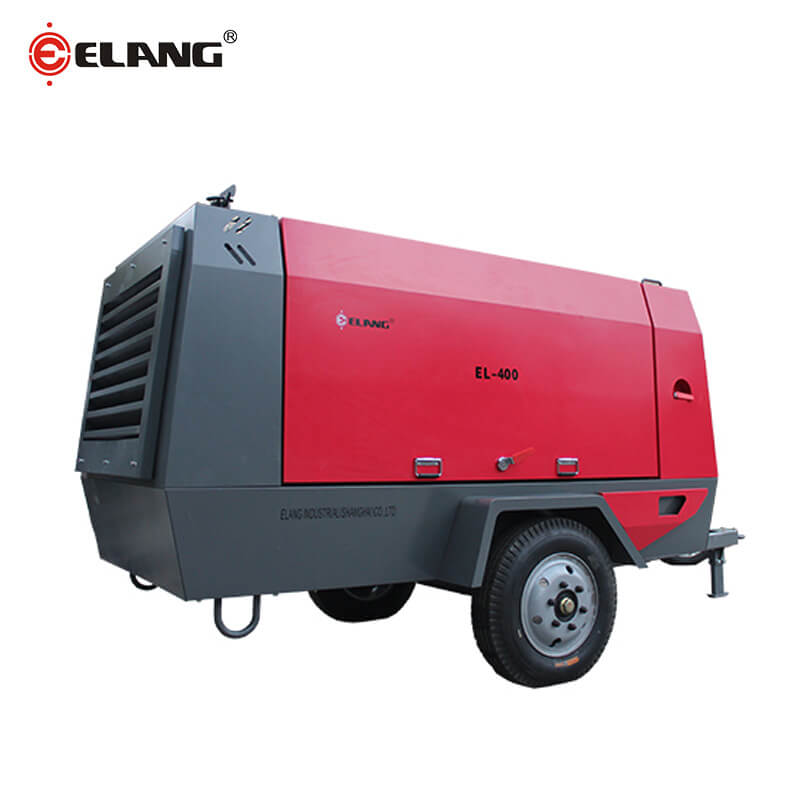-
Working pressure: 7~13bar 100~190psig Air delivery: 2.5~102m3/min 88~3600cfm Working power: 22~560kw 30~750hpdirect driven
-
Working pressure: 7~13bar 100~190psig Air delivery: 0.7~3.8m3/min 25~134cfm Working power: 7.5~22kw 10~30hpcombined
-
Working pressure: 6.5~13bar 95~190psig Air delivery: 0.5~102.0m3/min 17.7~3600cfm Working power: 5.5~560kw 7.5~750hp Frequency range: 40%~100%VSD
-
Working pressure: 6.5~13bar 95~190psig Air delivery: 0.5~102.0m3/min 17.7~3600cfm Working power: 5.5~560kw 7.5~750hp Frequency range: 40%~100%PM
-
Working pressure: 4.0~13bar 58~189psig Air delivery: 9.5~61.9m3/min 335.5~2189cfm Working power: 55~315kw 75~420hptwo-stage
-
Working pressure: 7~35bar 100~508psig Air delivery: 5.0~37.0m3/min 177~1310cfm Working power: 37~447kw 50~600hpportable

System Description of Screw Air Compressor Ⅲ
Hello everyone, today we will end the system description of screw air compressor with the remaining two system --- Safety protection system and warning device and Control System. Please refer to them as below.
Safety protection system and warning device
1. Motor overload protection
There are two main motors in the air compressor system, one is the air compressor driving the main motor, and the other is the cooling cycle fan motor. Under normal conditions, the running current of the motor will not exceed 10% of the rated current. (For example, due to voltage drop, three-phase unbalance, etc.) When the motor running current exceeds the upper limit set by the power protection device, the over current protection device will automatically cut off the main power supply and the air compressor will stop.
The reason for general motor overload: human operation error. Such as self-adjustment of exhaust pressure, improper system adjustment, etc.; mechanical failure: such as motor internal loss, motor under-phase operation, safety valve not operating, system setting failure, oil fine separator blocked, etc. If you find that the motor is overloaded during operation, you should immediately contact the manufacturer and send personnel to check to find out the cause. Otherwise, the motor will burn out.
2. Excessive exhaust temperature protection
The maximum exhaust temperature set by the system is 105-110℃, if it exceeds, the system will cut off the power automatically. Generally, there are many reasons for excessive exhaust temperature, but the most common reason is failure of the oil cooler. If the radiating fins of the air-cooled oil cooler are blocked by dust and cold air cannot pass through the cooler freely, the lubricating oil will gradually rise and cause high temperature shutdown. Therefore, it is necessary to use compressed air to remove the dust on the radiating fins at regular intervals. If the blockage on the fins cannot be blown out, it is best to clean it with a cleaning liquid or solvent.
Water-cooled air compressors generally suffer from high temperature trips due to fouling and clogging of cooling copper pipes, resulting in reduced heat transfer efficiency. The air compressor is designed with a maximum ambient temperature of 45℃. The higher the ambient temperature, the higher the exhaust temperature. Therefore, it is necessary to choose a place with a low ambient temperature and good ventilation to place the air compressor. When the intelligent controller detects that the temperature exceeds the set value, it will automatically cut off the power. At this time, the system cannot be restarted unless it is set again. In order to avoid over-temperature shutdown as much as possible, the system should be equipped with an early warning device. When the exhaust temperature reaches 100-105℃, the controller will send out an early warning signal to remind the operator.
3. Excessive exhaust pressure protection
When the system exhaust pressure exceeds the rated exhaust pressure by more than 0.5bar, the system will automatically cut off the power supply. When the air consumption is zero (the air supply valve is closed) and the discharge volume is less than the intake volume, the system pressure will rise rapidly, causing the safety valve to act and deflate. In order to avoid frequent actions of the safety valve and increase the safety factor of the machine, it is necessary to set this protection.
4. Lubricating oil pressure is too low protection (user selection)
When the system oil pressure is lower than 0.15-0.2MPa, the pressure switch sends out a signal to stop the motor and protect the host from being burnt due to lack of oil.
5. Alarm device
There are 3 types of alarm devices: air filter clogged, oil filter clogged, and oil fine separator clogged are all displayed on the LCD panel. When there is a fault indication on the panel, it means that a certain filter has been blocked, and the user must replace the spare parts in the shortest time, otherwise it will affect the performance and safe operation of the air compressor.
Control System
1. Motor starting (reduced voltage or Y running)
During this period, the (three-phase) solenoid valve must not be energized, the intake valve is fully closed, and the vent valve is fully opened. At this time, the intake side is vacuumed, and the lubricating oil required by the compressor and bearings is separated from the compression chamber and the oil and gas barrel. Ensured by the pressure difference.
2. The motor rotates under full pressure (full pressure or △ operation)
After the control is switched to full operation, the (three-phase) solenoid valve is energized, and the pressure in the oil and gas barrel gradually rises. When the pressure in the oil and gas barrel gradually rises above 0.15MPa, the intake valve is fully opened, so the pressure in the oil barrel is rapid When the pressure increases, the compressor starts to operate at full load. When the pressure rises to 0.45~0.50MPa, the minimum pressure maintenance valve is fully opened and air is output.
3. Heavy load/no load operation
When the exhaust pressure reaches the upper limit set by the system, the power supply is cut off, the (three-phase) solenoid valve is closed, so the intake valve is also closed, and the relief valve is fully opened at the same time to discharge the air in the oil and gas barrel to the atmosphere. When operating under no load, the required lubricating oil is ensured by the pressure difference between the compression chamber and the oil and gas barrel. When the pressure of the piping system drops to the lower limit set by the system, turn on the power again, the (three-phase) solenoid valve opens again, the intake valve is fully opened, and the relief valve closes, and the compressor runs under load.
4. Capacity adjustment operation
When the exhaust pressure gradually rises and does not reach the upper limit set by the system, it first reaches the set pressure of the regulator valve, causing the intake valve to gradually close. At this time, the system has begun to adjust. If the pressure continues to rise, the intake valve gradually closes until it is completely closed. Conversely, if the system pressure gradually decreases, the intake valve will gradually open, and the intake volume and pressure will gradually increase until it is lower than the set value of the regulator valve, then the adjustment action will stop. If the air consumption of the system is greatly reduced, the pressure rises too fast, and its speed exceeds the response capacity of capacity adjustment, the pressure sensor will send a signal to the controller, and the controller will de-energize the three-phase solenoid valve, and the intake valve will be closed. The machine is uninstalled and run. When the pressure is lower than the system set pressure value, the three-phase solenoid valve is energized, the intake valve opens, and the air compressor resumes heavy load operation.
5. Fan start and stop control
After the main engine is started, the fan will not operate temporarily, when the exhaust temperature reaches 80-85℃ (can be set on the PLC). The fan will start automatically. When the temperature drops to 70°C, the fan will stop running. On the one hand, it can save electricity, and on the other hand, it can make the exhaust temperature reach the temperature above the dew point in a short time. This is especially important in humid areas in winter, as far as possible to prevent the moisture in the air from precipitation.
6. Shutdown
After pressing the stop button, the (three-phase) solenoid valve is de-energized and closed, and at the same time, the relief valve is fully opened to discharge the air in the oil drum to the atmosphere. After a delay of 10-15 seconds, wait until the pressure in the oil drum drops At a certain value, the motor stops.
7. Emergency shutdown
When the exhaust gas temperature exceeds 105-110℃ or the overcurrent protection device is activated due to overload of the motor, the power supply will be cut off. The motor will stop immediately without delay. At the same time (three-phase) solenoid valve, intake valve and discharge valve are also closed. Then fully open. Only when abnormal conditions occur during the operation of the unit (such as oil leakage or serious air leakage, the exhaust temperature exceeds 110°C without automatic shutdown, the exhaust pressure exceeds 1.1 times the rated pressure without automatic shutdown, etc.), emergency shutdown is allowed Button to stop the machine immediately.
8. Automatic shutdown system without load for too long
If when the air volume of the system decreases, the compressor keeps running under no-load condition. If the no-load operation time exceeds the set time (usually set to 20 minutes), the air compressor will automatically stop and the motor will stop running. When the air volume of the system increases and the pressure of the system decreases, the air compressor will automatically start to supplement the air volume. The time limit for stopping the motor after running for too long without load is based on the principle that the number of starts of the motor per hour does not exceed twice. It can be set according to usage. Do not cause the motor to burn out frequently due to frequent starting times.
About Elang:
Product Recommendation:
Company News:
-
Wating to meet you in HANNOVER
Date: Apr 4, 2019
-
Why choose us
Date: Apr 19, 2019
-
Global Recruitment Agency
Date: Jul 19, 2019
-
PTC Asia Invitation
Date: Jul 25, 2019
-
How to Choose the Location of the Air Compressor Room?
Date: Aug 19, 2019
-
How to Arrange an Air Compressor Room?
Date: Sep 4, 2019
-
What are The Precautions for The Connecting Pipe of The Air Compressor?
Date: Sep 16, 2019
-
What are The Requirements for Water-Cooling Air Compressors?
Date: Oct 15, 2019
-
How to Ventilate the Air Compressor Room?
Date: Oct 29, 2019
-
What are The precautions for Installing The Main Circuit Cable of The Air Compressor?
Date: Nov 27, 2019
-
Analysis of Gumming and Carbon Deposit in Screw Air Compressor
Date: Dec 9, 2019
-
Advantages of Elang Oil Free Screw Air Compressor
Date: Dec 16, 2019
-
14 Tips for Compressor Operation
Date: Feb 14, 2020
-
ELANG 200kw Two-stage PM VSD Compressor Loading Flat Rack Container
Date: Mar 3, 2020
-
Why does Two-stage Screw Air Compressor Energy Saving?
Date: May 19, 2020
-
Elang Oil-free Air Compressor for Korean Instant Noodle Factory
Date: May 27, 2020
-
30m3/min 25bar Diesel Portable Compressor Delivery
Date: Jun 1, 2020








